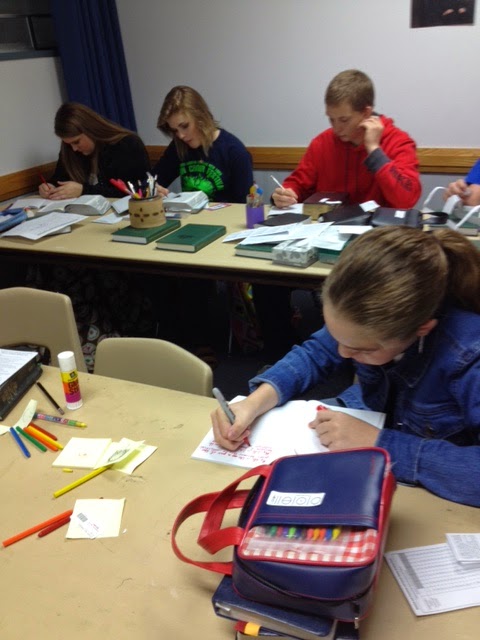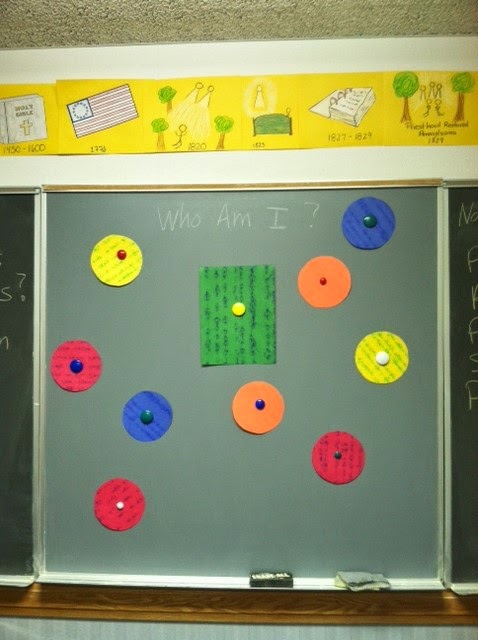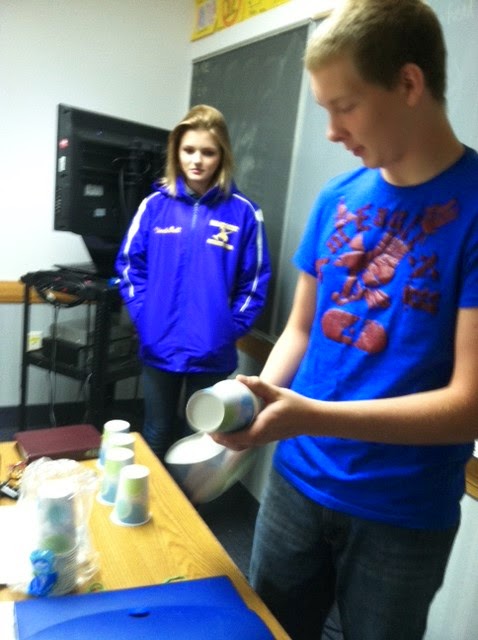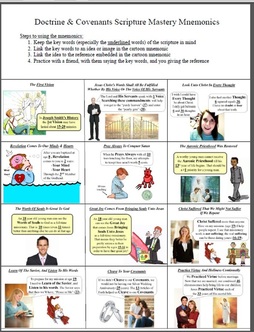Mormon Share > Feed Items
Feed Items
Pam Mueller
September 27, 2014

Spent three days studying Joseph Smith History this week. I wanted them to see they have a lot in common with him. (Fellow seminary teacher, Barb Gardner shared this idea) I put various names of objects on slips of paper and had them pick one out. They…
Pam Mueller
September 27, 2014

I have done this activity before to capture the attention of the students, have them involved and basically giving the lesson. On the board I put a picture of the person we will be studying under the rectangle of paper.Behind the circles are cluesI pic…
Pam Mueller
September 27, 2014

In learning about the Great Apostasy, this student started telling us about a Family Home Evening lesson his sister did. Using cups we have in our room, he gave us a visual of just what the apostasy was.you can do a google search and fin…
Pam Mueller
September 27, 2014

working in small groups to figure out the”Role of a Learner”
I gave them each this handout (from fellow seminary teacher Becky Edwards) and told them take two different colored pens, to go to a quite spot and discuss how to be a “learner”. Then we met back together to share what they learned.
Read these quotes. Mark in one color what actions you’re being invited to take to obtain spiritual learning. Mark in a second color the promised blessings of doing these things.
1. “The very process of formulating a question, raising a hand, asking a question and listening attentively is an expression of faith. This principle of seeking learning by faith invites individualized teaching by the Holy Ghost” (Elder David A. Bednar, Address to Australian Saints, April 2008).
2. “Assure that there is abundant participation because that use of agency by a student authorizes the Holy Ghost to instruct. It also helps the student retain your message. As students verbalize truths, they are confirmed in their souls and strengthen their personal testimonies” (Elder Richard G. Scott, “To Understand and Live Truth,” Feb. 4, 2005).
3. “We are to help students learn to explain, share, and testify of the doctrines and principles of the restored gospel. We are to give them opportunities to do so with each other in class. We are to encourage them to do so outside of class with family and others” (The Teaching Emphasis in the Church Educational System, November 14, 2007).
4. “When you encourage students to raise their hand to respond to a question, they signify to the Holy Spirit their willingness to learn. That use of moral agency will allow the Spirit to motivate and give them more powerful guidance during your time together. Participation allows individuals to experience being led by the Spirit. They learn to recognize and feel what spiritual guidance is. It is through the repeated process of feeling impressions, recording them, and obeying them that one learns to depend on the direction of the Spirit more than on communication through the five senses” (Richard G. Scott, “Helping Others to Be Spiritually Led,” 8/11/1998).
5. “Do you know how to get the most benefit from this time together? Write down the impressions you feel…Spiritual moments in life often come when it seems difficult to record them. Yet that special effort to crystallize in a permanent record sacred impressions of the Holy Ghost is powerfully rewarded. Begin now even if you have to borrow paper and pencil to do it.” (Richard G. Scott, BYU-I Devot., Feb. 24, 2004)
6. 1 Nephi 19:23 – …I did liken all scriptures unto us, that it might be for our profit and learning.
7. D&C 88:122 – Appoint among yourselves a teacher, and let not all be spokesmen at once; but let one speak at a time and let all listen unto his sayings, that when all have spoken that all may be edified of all, and that every man may have an equal privilege.
8. “The person at the pulpit’s most important purpose is to teach by the Spirit. Those in attendance must hear by the Spirit. The best way to hear by the Spirit that I have found is simply to have in your heart a prayer for the person who is speaking. If you will pray for the person who is speaking you will hear things you would not otherwise hear. The Spirit will say things that He might not otherwise say.” (Elder Dunn, quoted by Kelly Haws in Priesthood training mtg)
I Accept God’s Invitation to be an Active Learner this Year in Seminary.
Signature_______________________________________________________
The Personal Progress Helper
September 26, 2014

I don’t know what it is with me and BINGO and General Conference, but for as long as I can remember all three have been associated with each other. It started out as a way for me to pay attention, but now with maturity and a longer attention span, I’v…
Jennifer Smith
September 25, 2014

By [email protected] (Sheena Perron) IDENTIFY THE DOCTRINE(acting out a story): Tell the following story, and invite the children to act it out with you: “You were camping in the mountains with your family when a huge snowstorm hit (shiver). You couldn’t see the trail back to your campsite (hold hand over eyes, searching). Then your father came, wearing big, heavy boots (walk in place). He said, ‘I know the way!…
Read more
Sheena Perron
September 24, 2014

IDENTIFY THE DOCTRINE(acting out a story): Tell the following story, and invite the children to act it out with you: “You were camping in the mountains with your family when a huge snowstorm hit (shiver). You couldn’t see the trail back to your campsite (hold hand over eyes, searching). Then your father came, wearing big, heavy boots (walk in place). He said, ‘I know the way! Follow me!’ Father made big footprints in the snow for you to follow.” Explain that just as we could follow the father’s footprints, others can see and follow the good example we set when we live the gospel. Ask the children to repeat after you, “By living the gospel I set a good example for others to follow.”
ENCOURAGE UNDERSTANDING AND APPLICATION (reading a scripture and discussing standards): Have the children read 1 Timothy 4:12. Write some statements from For the Strength of Youth that you feel are appropriate for the children on separate pieces of paper, and put them in a container. Invite a child to pick one statement and share a personal experience with that standard or tell how living that standard sets a good example for others to follow. Repeat with the other statements. Sing “I Want to Live the Gospel” (CS, 148).
Sharing Time Ideas from Little LDS Ideas
When I read this week’s Sharing Time theme I quickly thought of ‘Bee’ and Example. I just didn’t know how I would incorporate bees into Sharing Time. Then I thought of the cute ‘fly swatter’ Singing Time idea I have seen all over the place….perfect!
For this week’s Sharing Time you will be ‘swatting’ bees and discussing how living certain standards sets a good example for others. You could play this activity several different ways, read below to find out how to play.
First, you will need to download and print my Bee cards (Found HERE) or create your own. The front of the cards says: “Bee an Example” and the back has different phrases from the ‘For the Strength of Youth’. Print them, cut them and then glue them together so that there is a front and a back.
Place your Bee cards onto a table at the front of the Primary Room. You will also need to place a large piece of packaging tape (roll it) onto the fly swatter.
Invite a child up to the front and tell them to ‘swat’ a bee. The tape should stick to one of the bee cards, they may have to swat a few times to get one to stick. Once they have chosen a card have them read the phrase on the back. Invite the child to share a personal experience with that standard or tell how living that standard sets a good example for others to follow.
Remove the bee and then invite another child up to the front to swat the next bee.
{You may need to replace the piece of tape a few times during the activity.}
Instead of having phrases (standards) on the back you could have different scenarios. Have the children take turns swatting at the bees and then ask them if that is a way to ‘Bee’ and example. You could then discuss why or why it isn’t.
For this optionyou will need 6 envelopes labeled 1-6. On the back of each ‘Bee’ card you will also write a number 1-6.
Inside of the envelopes have standards from the ‘For the Strength of Youth’ or different scenarios.
Take turns having a child swat a bee and then find the corresponding envelope. Have them read what is inside the envelope and discuss it as a primary.
One more option: For this you will also need 6 envelopes, but instead of numbering them write short phrases/standards on the front of the envelope (i.e. Honesty, Good Language, Modesty, etc.). Inside the envelope have an explanation of that specific standard found in the ‘For the Strength of Youth’.
On the bees write the beginning of a scenario
“You are at school when you hear your friend say a word that you are not allowed to say.”
Have the child look at each of the envelopes and decide which standard belongs to their scenario. Have them open the envelope and read what is inside. Then discuss what they could do to ‘Bee’ an Example.
Here are what my ‘Bee’ cards look like. There are 2 pages: One page of the front {Bee an Example} & one page of the back {Standards}.
If you would like to use my cards just click the link below to download
I hope you enjoy my ‘Bee’ an Example activity for this week’s Sharing Time. If you have any questions or problems feel free to leave a comment or send me an email {littleldsideas(at)hotmail(dot)com}.
Thanks so much for stopping by. Have a great day & a wonderful Sharing Time.

Jennifer Smith
September 24, 2014
Jennifer Smith
September 24, 2014

As I have talked about in past posts, to learn the Scripture Masteries, it is best to spotlight one scripture a week. BUT you can’t very well scripture chase with only one scripture you have learned. Well the document here (front and back) has all the mnemonics for the D&C. On a “Flexible day” in the Pacing Guide, you may want to go over the first 6 mnemonics and have…
Read more
Jennifer Smith
September 24, 2014
By Erin Isenberg In September of 2014, most of us will be focussed on Primary Program review. Try the activities on my page Review Links for the 2014 Primary Program. There you’ll find a list of activities, games, tips and tools for your upcoming performance. You might even consider trying one of these fun arrangements of the 2014 songs. Since September 21 is the first day of fall (or spring…
Read more
Jennifer Smith
September 24, 2014
By LDS Scripture Teachings The following account comes to us from chapter 6 of the book entitled, The Prophet Joseph: Essays on the Life and Mission of Joseph Smith, by Larry Porter and Susan Easton Black: The power that rested upon Joseph Smith … Continue reading → Source:: Seminary Teacher – Mike Day
Scott Knecht
September 24, 2014
In recent years there has been a welcomed trend towards inviting students to do more in their own learning. This is a very good thing as mental immobility rarely results in learning. But as with all trends that feel good, we tend to keep pu…







